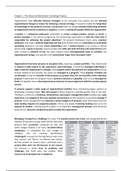Samenvatting
Summary Project Management - all chapters for Information Management exam of the book ("INFORMATION TECHNOLOGY PROJECT MANAGEMENT")
- Instelling
- Tilburg University (UVT)
Summary of all chapters necessary for the exam Project Management by J. Hulstijn (Tilburg University). The book is: INFORMATION TECHNOLOGY PROJECT MANAGEMENT (FIFTH EDITION) - Providing Measurable Organizational Value (Jack T. Marchewka). The chapters: 1, 2, 3, 5, 6, 7, 8.
[Meer zien]





